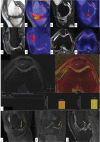Qualitative and Quantitative Evaluation of Morpho-Metabolic Changes in Bone Cartilage Complex of Knee Joint in Osteoarthritis Using Simultaneous 18F-NaF PET/MRI-A Pilot Study
- PMID: 37123591
- PMCID: PMC10132889
- DOI: 10.1055/s-0042-1760285
Qualitative and Quantitative Evaluation of Morpho-Metabolic Changes in Bone Cartilage Complex of Knee Joint in Osteoarthritis Using Simultaneous 18F-NaF PET/MRI-A Pilot Study
Abstract
Background Articular cartilage (AC) loss and deterioration, as well as bone remodeling, are all symptoms of osteoarthritis (OA). As a result, an ideal imaging technique for researching OA is required, which must be sensitive to both soft tissue and bone health. Objective The aim of this study was to assess the potential of simultaneous 18F sodium fluoride (18F-NaF) positron emission tomography/magnetic resonance imaging (PET/MRI) to identify as well as classify osseous metabolic abnormalities in knee OA and to see if degenerative changes in the cartilage and bone on MRI might be correlated with subchondral 18F-NaF uptake on PET. Methods Sixteen (32 knees) volunteers with no past history of knee injury, with or without pain, were enrolled for the research from January to July 2021. The images of both knees were taken utilizing an molecular magnetic resonance (mMR) body matrix coil on a simultaneous PET/MRI biograph mMR. The acquisition was conducted after 45 minutes of intravenous infusion of 18F-NaF 185-370 MBq (5-10 mCi) over one PET bed for 40 minutes, while MRI sequences were performed simultaneously. Results All pathologies showed significantly higher maximum standardized uptake value (SUV max ) than the background. Thirty-four subchondral magic spots were identified on 18F-NaF PET without any structural alteration on MRI. Bone marrow lesions (BMLs) and osteophytes with higher MRI osteoarthritis knee score (MOAKS) score showed higher 18F-NaF uptake (grade1˂grade2˂grade3). BMLs had corresponding AC degeneration. There was discordance between grade 1 osteophytes (86.6%), sclerosis (53.7%) and grade 1 BML in cruciate ligament insertion site (91.66%); they did not have high uptake of 18F-NaF. In case of cartilage, there was significant difference between AC grades and average subchondral SUV max and T2* relaxometry (grade0˂grade1˂grade2˂grade3˂grade4). BMLs are much more metabolically active than other pathologies, while sclerosis is the least. We also found that the subchondral uptake was statistically increased in the areas of pathology: Conclusion 18F-NaF PET/MRI was able to detect knee abnormalities unseen on MRI alone and simultaneously assessed metabolic and structural markers of knee OA across multiple tissues in the joint. Thus, it is a promising tool for detection of early metabolic changes in OA.
Keywords: bone; cartilage; knee joints; osteoarthritis; simultaneous PET/MRI.
Indian Radiological Association. This is an open access article published by Thieme under the terms of the Creative Commons Attribution-NonDerivative-NonCommercial License, permitting copying and reproduction so long as the original work is given appropriate credit. Contents may not be used for commercial purposes, or adapted, remixed, transformed or built upon. ( https://creativecommons.org/licenses/by-nc-nd/4.0/ ).
Conflict of interest statement
Conflict of Interest None declared.
Figures



References
-
- Azad C S, Singh A K, Pandey P. Osteoarthritis in India: an epidemiologic aspect. Int J Recent Sci Res. 2017;8(10):20918–20922.
-
- World Health Organization “Chronic Rheumatic Conditions.” Chronic diseases and health promotion 2012. Accessed December 17, 2022 at:http://www.who.int/chp/topics/rheumatic/en/
-
- Teitel A D, Zieve D.MedlinePlud Medical Encycolpedia. National Institutes of Health. “Osteoarthritis.”Accessed December 17, 2022 at:http://www.nlm.nih.gov/medlineplus/ency/article/000423.htm
-
- OAI Investigators . Wirth W, Buck R, Nevitt M. MRI-based extended ordered values more efficiently differentiate cartilage loss in knees with and without joint space narrowing than region-specific approaches using MRI or radiography–data from the OA initiative. Osteoarthritis Cartilage. 2011;19(06):689–699. - PMC - PubMed
LinkOut - more resources
Full Text Sources
Research Materials
Miscellaneous

